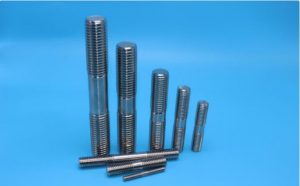The Differences Between Stainless Steel Bolts And Stainless Steel Studs
Maybe some people can’t tell the difference between stainless steel bolts and stainless steel studs. As a professional fastener manufacturer, Xinchi Fastener Company has many years of experience in the fastener industry. We are happy to give you a brief introduction to this situation, hoping to be helpful to you.
Stainless steel bolts and stainless steel studs differ in appearance.
Stainless steel bolts often refer to those with heads and larger ones, such as hexagonal bolts.
Stainless steel screws refer to smaller, such as hex screws, pan head/flat head/large flat head/round head machine screws, and so on.
Stainless steel studs should be headless and cannot be rotated by tools.
Common ground: They are threaded fasteners.


Stainless steel bolts and stainless steel studs differ in applications.
A stainless steel bolt is a mechanical part, a cylindrical threaded fastener used in conjunction with a nut. A bolt is a type of fastener consisting of a head and a screw (a cylinder with external thread). It needs to be fitted with a nut to fasten two parts with a through the hole. This type of connection is called bolted connection. If the nut is unscrewed from the bolt, the two parts can be separated, so the bolt connection is a detachable connection.
bm=1d double stud is generally used for the connection between two steel connectors; bm=1.25d and bm=1.5d double studs are generally used for the connection between the cast iron connector and the steel connector; bm=2d double stud is generally used for the connection between aluminum alloy connector and steel connector. The former connector is provided with an internally threaded hole and the latter with a through hole.
Both ends of equal-length stainless steel double stud threads should be matched with nuts and washers for two connected parts with through holes.
One end of the welding stud is welded to the surface of the connected piece, and the other end (threaded end) passes through the connected piece with a through hole, and then the washer is put on, and the nut is screwed on so that the two connected pieces are connected as a whole.
A stud is a type of fastener with no head and only external threads at both ends. In connection, one end of the stud must be screwed into the part with the internally threaded hole, the other end through the part with the through hole, and then screw the nut so that the two parts are securely joined into a single piece. This type of connection is called a stud connection and is also a detachable connection. The stud is mainly used in the following situations: the thickness of one of the connected parts is large, requiring a compact structure. Or due to frequent disassembly, it is not suitable to use a bolt connection.
As a one-stop fastener company, we can provide a wide range of fasteners including stainless steel nuts, carbon steel nuts, 4 prong t nuts, bolts, screws, washers, and so on. Non-standard custom fasteners are also available as long as you provide the corresponding requirements and drawings. If you want to wholesale fasteners or want to consult fastener-related knowledge, please contact us, and our experienced service team will reply to you as soon as possible.

